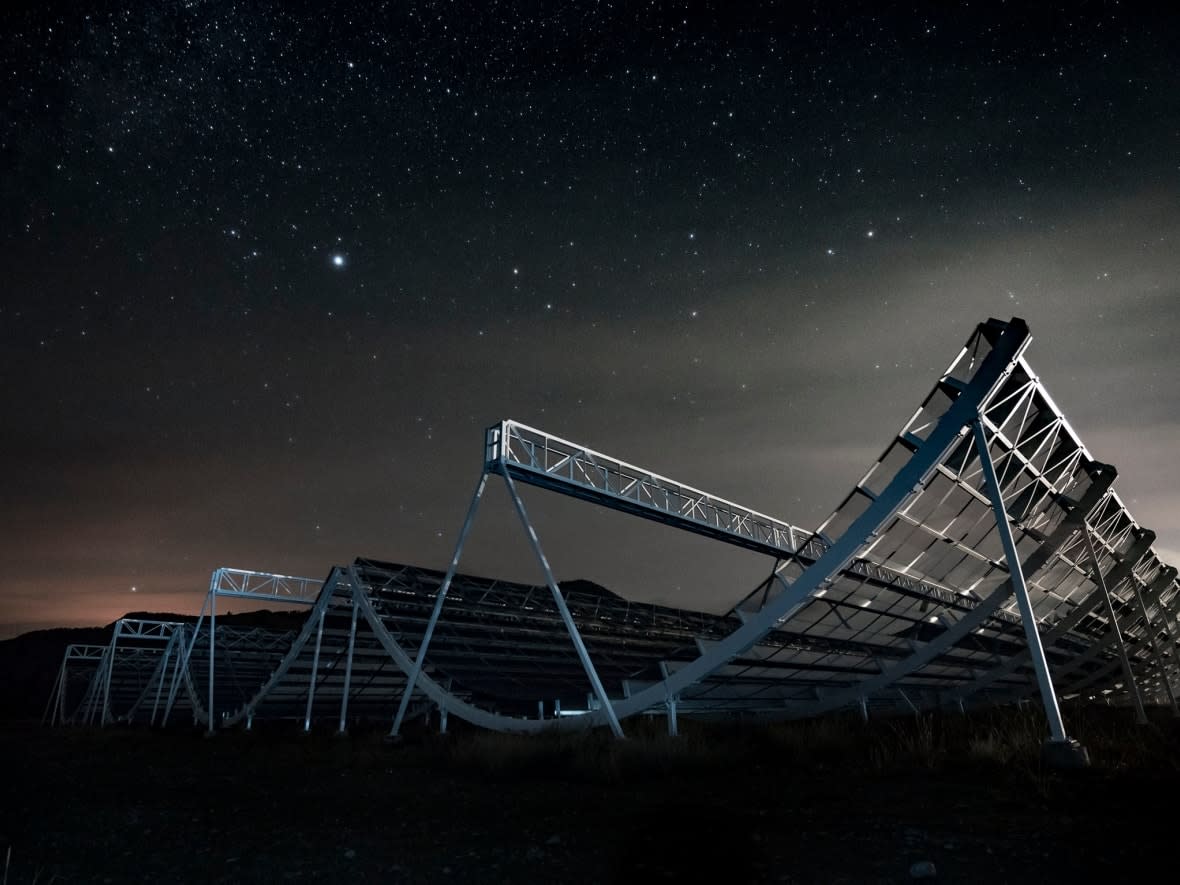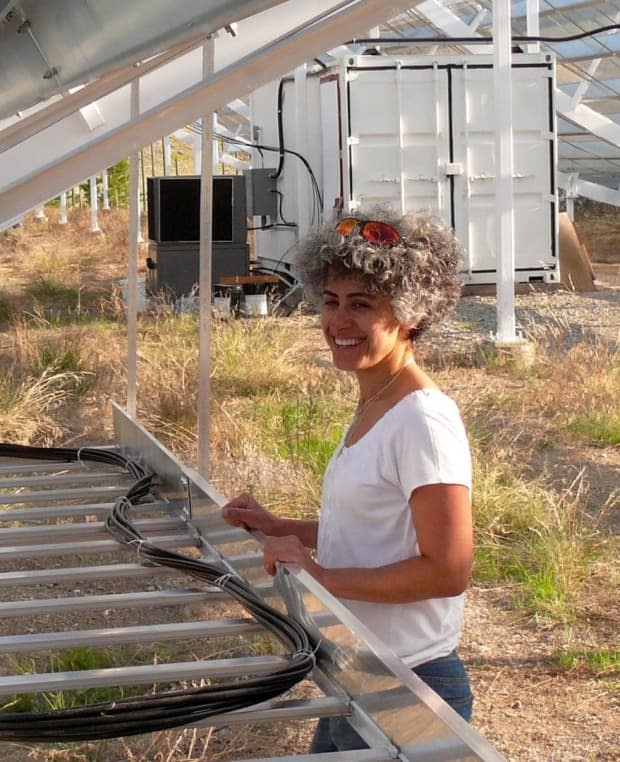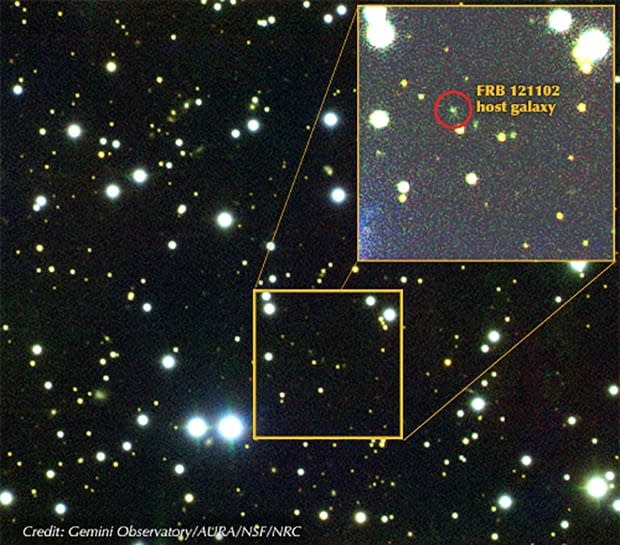Canadian team wins prestigious award for work unravelling some of the mysteries of our universe

At first glance, it looks like anything but a telescope. Maybe a half-pipe for incredibly ambitious skateboarders, but a telescope? Definitely not.
This unique eye into the cosmos — which had its first light on Sept. 7, 2017 — is called the Canadian Hydrogen Intensity Mapping Experiment (CHIME), and is located near Penticton, B.C. It has already shed light on some of the most mysterious objects in the universe, called fast radio bursts, to name but one accomplishment.
Now, the CHIME team of roughly 100 has been awarded the Natural Sciences and Engineering Research Council of Canada's (NSERC) Brockhouse Canada Prize for Interdisciplinary Research in Science and Engineering, which includes a $250,000 grant.
The awards are handed out in several categories each year, with the Gerhard Herzberg Canada Gold Medal for Science and Engineering being the top award that can be worth $1 million. This year's award went to Lenore Fahrig at Carleton University for her work on wildlife conservation.
WATCH | CHIME telescope unveiled in B.C.
In part, the citation for the CHIME scientists reads: "The CHIME team has … created a progressive training environment for students, postdoctoral fellows and research associates. The team proudly includes members of underrepresented groups in physics. Their award-winning collaboration has already produced profound new knowledge about some of the greatest mysteries of our universe, with major advances still anticipated. It is truly one of the biggest success stories in Canadian astrophysics."
The announcement was made Tuesday morning.
"We're clearly very happy with this," said Mark Halpern, an astronomer and professor at the University of British Columbia who is also a CHIME team member. "We think of this really clearly as a team award to the CHIME team. And it's a big bunch of people who've been there: super talented students and post docs, and so on."
Some of the special qualities about the telescope is that it has no moving parts, and that it is able to scan the entire sky night after night.
This ability to have such a wide-field view means the telescope can do a lot more and a lot faster.
Mandana Amiri, CHIME's project manager, said she's happy about the announcement, as it has come with a lot of work.
"Our team really deserved this, especially on the cosmology side," she said. "Because we need more data to be able to analyze and get the science we want. It's been a long wait for some of the students and strange times, of course. So I thought this was well timed, and called for."
Weird signals from space
In 1929, famed astronomer Edwin Hubble — for whom the space telescope is named — discovered that the universe is expanding. Since then, we've come to realize that it's expanding faster than we thought.
The reason for that is believed to be linked to dark energy, an invisible force that makes up roughly 68 per cent of the observable universe.
CHIME's main directive is to create a three-dimensional map of hydrogen gas in distant galaxies that were heavily affected by dark energy to study the expansion rate of the universe. Halpern said he believes that should be completed within the next two years.

But one of the most prolific research to come out of CHIME since it first opened its eyes on the universe is on fast radio bursts, or FRBs.
FRBs are extremely brief bursts of radio waves from beyond our Milky Way. The first one was reported in 2007 after an astronomer went through data collected in 2001 at a telescope in Australia. Theories as to what could be producing them included a special type of pulsar (small, rapidly rotating, dense stars that emit radio signals as they rotate, almost like a cosmic lighthouse).
Then, in 2015, Paul Scholz, a PhD student at McGill, found the first repeating one (FRB 121102), which further puzzled astronomers.
In stepped the CHIME team. In 2019, the telescope captured 13 more FRBs, but more importantly, only the second repeater. By the end of that year, eight more repeaters had been discovered. In 2020, the team published a study that found a local FRB — just 30,000 light years away — came from a magnetar, an intensely magnetized star.

When the new telescope was unveiled in 2017, only 30 FRBs had been detected. Today, CHIME has detected roughly 3,000, Halpern said.
"They come in all kinds of categories. Some of them repeat, others don't seem to. Some of them are quite near, that is, adjacent nearest galaxies, and some are quite far away," he said.
"I think in that context, just the sheer number and the richness of that data set, that's an accomplishment."
What makes Halpern particularly happy about winning this award is that it is truly a Canadian scientific endeavour.
"It feels really nice [to] have a whole idea, and have Canada step up and fund the whole thing," he said.
He said the project is "both pan-Canadian and very Canadian" — it involves schools throughout the country, is funded by Canada and the research is being conducted on Canadian soil.
"It feels nice that the country says, 'Yes … it worked.' And thank you."
A full list of NSERC winners can be found here.


